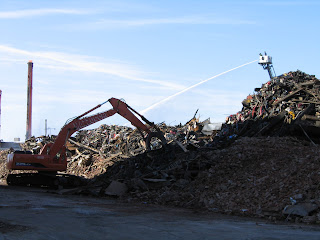Hope everyone survived Sandy, the Nor'easter, and Thanksgiving! Since Sandy we've been getting a lot of phone calls on handling all the different issues related to the super storm. Questions regarding mold, asbestos, lead, and the use of
biocides. In order to assist with providing information on these issues their are several videos we have worked with IAQTV and Cochrane & Associates to provide some basic information on these issues. The most recent video is based on what it takes to dry out an area based on the type of water that has infiltrated the area. See our video "Dry Out Hazards Following a Flood or Water Incursion" at:
http://www.youtube.com/watch?v=64u9RNPKbtI&feature=em-uploademail
 |
| Superstorm Sandy Uprooted/Broke Many Trees Causing Severe Power Outages |
After super storm Sandy
building materials were probably disturbed and may have become damaged requiring removal or replacing. Anytime you are dealing with building materials, you are probably going to have to deal with asbestos and/or lead.
Asbestos was typically used as an insulator, however, the material can also be found in floor tiles & mastics, plaster-on-lathe, ceiling tiles, siding shingles, window caulking, & roofing shingles (remember asbestos is not banned and can be found in certain new building materials). For more information about asbestos threats in the home, see our video "Asbestos Threats in the Home" at:
http://www.prlog.org/10943541-asbestos-threats-in-the-home-revealed-in-new-video.html. In New York State workers and companies that disturb or handle asbestos are required to be certified and licensed. In addition, projects that disturb/handle asbestos in quantities greater than 10 square feet and/or 25 linear feet require asbestos air/project monitoring to determine if the project has been completed properly. This air/project monitoring firm and individuals must also be licensed and certified and are required to be completely independent of the contractor (must be hired by the owner of the facility/residence) handling/disturbing the asbestos.
Lead was usually used in paint and also in window caulking. For more information about lead in the home, see our video "Lead Hazards in the Home" at:
http://www.youtube.com/watch?v=z5UnRr0tj88. The Environmental Protection Agency (
EPA) under the
Renovation, Repair, and Painting Rules (RRP) requires renovation, remodeling, and painting contractors must be certified in lead paint work procedures. Visit EPA's website regarding how this rule applies for post-disaster renovations:
http://epa.gov/lead/rrp/emergency.html .
With significant water infiltration on the shore areas, if these areas were allowed to stay damp for longer than 48-hours, then mold had the opportunity to grow. The extent of
mold growth and type of mold would be based on the type of water (black, grey, or white) and the amount of water. To learn more about mold see our video "Health Effects of Mold Exposure" at:
http://www.youtube.com/watch?v=DbKoonHwvHM For those who have had sewage water (known as black water) infiltration into their residence/facility should see our video "
Sewage Contamination Dangers" at:
http://www.youtube.com/watch?v=V4XORptvcX8. When looking for contractors to handle mold, unlike asbestos and lead there is no federal, state or local licensing. However, you should make sure the contractor you hire has workers who are industry certified in mold remediation from the American Council for Accredited Certifications (ACAC). Find the ACAC and those certified individuals at:
http://acac.org/.
When it comes to biocides it is very important to be cautious, when using bleach or other stronger biocides. Biocides (meaning kills life) are designed to kill and must be registered (licensed) with EPA under the
Federal Insecticide, Fungicide, Rodenticide Act (
FIFRA). The label is the law for these products. Meaning the chemical must be used in accordance with the label. The label must list all the limitations and where the product is allowed to be used. For information about biocides visit EPA's website on FIFRA at:
http://www.epa.gov/lawsregs/laws/fifra.html and visit the following website for registered disinfectants:
http://www.epa.gov/oppad001/chemregindex.htm Remember EPA does
NOT recommend the use of biocides for mold cleanups, visit EPA's website regarding using bleach for mold cleanups at
http://iaq.supportportal.com/link/portal/23002/23007/Article/20290/Should-I-use-bleach-to-clean-up-mold . See EPA's website and the EPA manual "A Brief Guide to Mold, Moisture, and Your Home" at:
http://www.epa.gov/mold/moldguide.html.
To quote a Long Island retailer, "An educated consumer is our best customer.". In the case of environmental hazards it is the same. Educate yourself on the hazards and you can better avoid hazards, unnecessary expenses & services, and headaches. Please be safe and take care!














